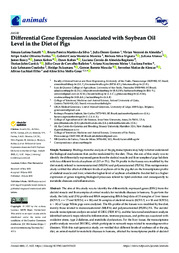Differential gene expression associated with soybean oil level in the diet of pigs.
Differential gene expression associated with soybean oil level in the diet of pigs.
Author(s): FINALLI, S. L.; SILVA, B. P. M. DA; GOMES, J. D.; ALMEIDA, V. V. DE; FREITAS, F. A. O.; MOREIRA, G. C. M.; VIGNATO, B. S.; AFONSO, J.; REECY, J.; KOLTES, J.; KOLTES, D.; REGITANO, L. C. de A.; GARRICK, D. J.; BALIEIRO, J. C. DE C.; MEIRA, A. N.; FREITAS, L.; COUTINHO, L. L.; FUKUMASU, H.; MOURÃO, G. B.; ALENCAR, S. M. DE; LUCHIARI FILHO, A.; CESAR, A. S. M.
Summary: The aim of this study was to identify the differentially expressed genes (DEG) from the skeletal muscle and liver samples of animal models for metabolic diseases in humans. To perform the study, the fatty acid (FA) profile and RNA sequencing (RNA-Seq) data of 35 samples of liver tissue (SOY1.5, n = 17 and SOY3.0, n = 18) and 36 samples of skeletal muscle (SOY1.5, n = 18 and SOY3.0, n = 18) of Large White pigs were analyzed. The FA profile of the tissues was modified by the diet, mainly those related to monounsaturated (MUFA) and polyunsaturated (PUFA) FA. The skeletal muscle transcriptome analysis revealed 45 DEG (FDR 10%), and the functional enrichment analysis identified network maps related to inflammation, immune processes, and pathways associated with oxidative stress, type 2 diabetes, and metabolic dysfunction. For the liver tissue, the transcriptome profile analysis revealed 281 DEG, which participate in network maps related to neurodegenerative diseases. With this nutrigenomics study, we verified that different levels of soybean oil in the pig diet, an animal model for metabolic diseases in humans, affected the transcriptome profile of skeletal muscle and liver tissue. These findings may help to better understand the biological mechanisms that can be modulated by the diet.
Publication year: 2022
Types of publication: Journal article
Observation
Some of Embrapa's publications are published as ePub files. To read them, use or download one of the following free software options to your computer or mobile device. Android: Google Play Books; IOS: iBooks; Windows and Linux: Calibre.
Access other publications
Access the Agricultural Research Database (BDPA) to consult Embrapa's full library collection and records.
Visit Embrapa Bookstore to purchase books and other publications sold by Embrapa.

